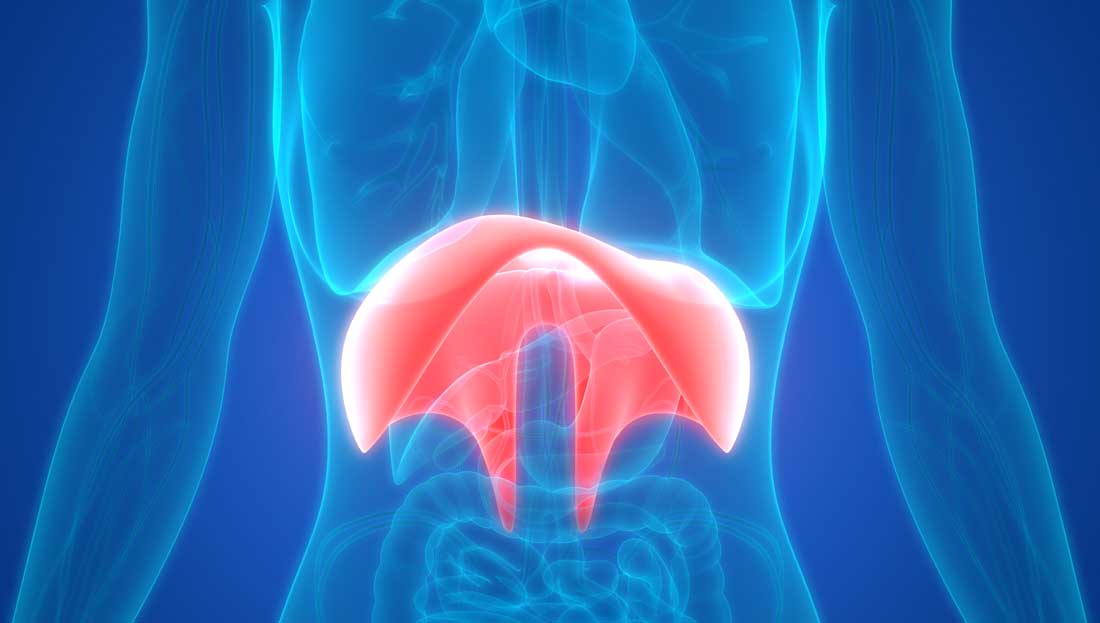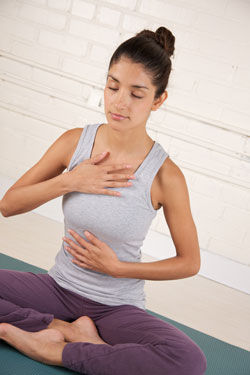
When you think of core stabilizing muscles, what comes to mind? The transverse abdominis? The multifidi? There’s one muscle you probably didn’t consider: the diaphragm.
Core stability—and the muscles and methods to achieve it—are hot topics in the health and fitness industry. We program corrective exercises designed to facilitate the transverse abdominis or activate the spinal erectors, but pay little attention to the dome-shaped muscle between them. If you want to help your clients develop core stability that comes from the inside out, it’s time to turn your attention to the diaphragm.
Diaphragm 101
The respiratory diaphragm is a muscle that sits posterior to the rib cage and inferior to the lungs, anatomically separating the thorax from the abdomen. During inhalation, the diaphragm contracts and descends toward the abdomen, reducing pressure in the lungs. This drop in pressure causes air to rush in. As the diaphragm relaxes and ascends, lung pressure increases and exhalation ensues.
“The diaphragm is our chief breathing muscle,” says Jill Miller, C-IAYT, E-RYT, author of The Roll Model and co-founder of Tune Up Fitness. “Without even trying to activate it, your brain is going to do it for you.”
The diaphragm is unique in its many bony and soft-tissue attachments. “It attaches directly to the lower six ribs on the inner surface of the rib cage, the bottom of the sternum at the xiphoid process, and to the lumbar spine,” Miller says. “It also has soft-tissue attachments to the quadratus lumborum, psoas and transverse abdominis.”
Additionally, it shares fascial attachments with the pelvic floor, often referred to as the pelvic diaphragm. The two diaphragms work in concert to maintain intra-abdominal pressure during breathing; as the respiratory diaphragm descends and ascends, so too does the pelvic floor. Further, the diaphragm has ligamentous attachments connecting it to the lungs, heart, esophagus, small intestine and colon (Bordoni and Zanier, 2013).
Because of these numerous bony and soft-tissue attachments, diaphragmatic function has vast implications on the entire body.
The Diaphragm and Stability
While the diaphragm is well known as the primary respiratory muscle, its role in stabilization is often overlooked. “The diaphragm has a secondary role in core stability,” says Mike Reinold, D.P.T., of Champion Physical Therapy and Performance. “Because it sits at the top of the abdominal cavity, it functions with the abdominal muscles and pelvic floor to provide core stability when braced.”
Without diaphragmatic contribution, the spine is not fully stabilized and we have to rely on more peripheral trunk muscles to help out. This limits both spinal stability and efficient transfer of energy, as the peripheral muscles, which are best suited for force production and transfer, are unduly burdened by stability requirements.
Luckily, we don’t have to suspend the diaphragm’s respiratory function to unleash its stabilizing capacity. “The diaphragm can help you breathe no matter what position you’re in, but it’s hindered when you’re inhibited by the other trunk muscles that share the same attachments,” Miller says.
Not only does the diaphragm have to contract, it has to contract at the right time. If the abdominal wall contracts first or has a high degree of tension, the movement available to the diaphragm is restricted, and a full contraction is inhibited. “Because the respiratory diaphragm and transverse abdominis share fascial connections, the relationship between the two has tremendous impact on posture and the behavior of the diaphragm,” says Miller. As such, tension in the transverse abdominis may limit the range of motion available to the diaphragm and decrease its stabilization capacity.
Drawing in the Stomach
People who are wary of the abdominal region may consciously or unconsciously draw in their stomachs, which engages the transverse abdominis. “If the transverse abdominis is contracting,” explains Miller, “the diaphragm can’t do its job.”
To interrupt this pattern, Miller suggests that we change our perspective and understanding of the shapes of our bodies. “We need to get rid of the word flat when we talk about the human body,” she says. “All tissues have a curve to them and reinforcing the concept of flat abs is problematic.”
To put this in to practice, check in with your abdomen at regular intervals throughout the day. As a health and exercise professional who is constantly standing, exercising and projecting your voice, you may notice you subconsciously draw in your abdominal muscles. If so, consciously release the tension in your belly and focus on taking deep and expansive breaths through the abdomen and rib cage. You may find that this release slightly changes your physical shape. Miller urges us to respect that bodily quality. “The diaphragm is just like us—curved and asymmetrical—and it’s totally fine,” she says.
The Diaphragm and Breath
The diaphragm is the body’s chief breathing muscle. As a result, if its range of motion is restricted, problems ensue.
 “When the diaphragm is not able to contract fully, we’re forced to use our secondary muscles of respiration, which can lead to neck, shoulder and chest pain,” says Elizabeth Delozier, D.P.T., who specializes in pelvic floor physical therapy. “Numerous factors, including overactivity of the abdominal muscles, rib position, pain, pregnancy, surgeries and injuries can all contribute to restriction of the diaphragm,” she says.
“When the diaphragm is not able to contract fully, we’re forced to use our secondary muscles of respiration, which can lead to neck, shoulder and chest pain,” says Elizabeth Delozier, D.P.T., who specializes in pelvic floor physical therapy. “Numerous factors, including overactivity of the abdominal muscles, rib position, pain, pregnancy, surgeries and injuries can all contribute to restriction of the diaphragm,” she says.
Predictably, if the diaphragm can’t do its job, the brain will engage other muscles to take over. “The body will do anything it can to get air,” Miller says. When the diaphragm can’t fully contract, the brain will recruit secondary respiratory muscles, the intercostals, or tertiary respiratory muscles, which are in the neck and shoulders, to get the job done.
To rectify this compensatory response, experts recommend diaphragmatic breathing and encourage belly distension with each breath. However, the phrase “diaphragmatic breathing” lacks utility.
“The term diaphragmatic breathing is somewhat of a misnomer,” says Reinold. “You couldn’t breathe without the diaphragm, even if you tried.” While consciously moving upper-chest breathing toward the abdomen will increase diaphragmatic contribution, a full breath involves more than anterior abdominal distension.
Because of the diaphragm’s multiple insertion points on the anterior, lateral and posterior sides of the body, a full breath will cause abdominal and thoracic distension in multiple directions.
To get a feel for this distension, place your hands around the bottom of your rib cage, so your fingertips reach toward your upper abdomen and your thumbs reach towards your thoracic spine. Take a full breath in and feel for your rib cage and midsection to expand forward into your fingertips, laterally into your palms and posteriorly into your thumbs.
Beyond improvements in breathing and stability, enhanced diaphragmatic function also has benefits for physical and emotional health.
The Diaphragm and Mind-body Health
When the diaphragm doesn’t function to its full capacity, other muscles will bear the burden. “The body will shift the demands of respiration to your secondary or tertiary respiratory muscles, and that’s not energy efficient; it costs the body a lot,” says Miller. “These muscles will [signal] their overuse by causing fatigue or pain,” she says. “Inappropriate use of a muscle plus time equals pain.”
The body associates these secondary breathing patterns with sympathetic arousal, and their use can propel us into a fight or flight state. “This can lead to adverse outcomes like increased muscular tension, anxiety, fatigue and impaired digestive function,” says Miller. Further, being in a sympathetic state affects muscle spindles throughout entire body, adding to unconscious tension throughout your nervous system.
To experience this sensation yourself, Delozier recommends the following exercise: Close your eyes and take 10 fast breaths into the top of your chest without letting your belly expand. “Do you notice your blood pressure rising? Perhaps you feel more stress and anxiety?” she asks. Now close your eyes and slow your breath down, allowing your belly to expand and contract with each inhalation and exhalation. “Do you feel more relaxed and at ease?” she questions. Because upper-chest breathing is a component of the body’s fight or flight response, it has a bidirectional relationship with stress and anxiety. We activate upper-chest breathing when we’re stressed, and when this breathing pattern is inadvertently activated, stress follows, leading to a cycle that can perpetuate chronic stress.
“When you release the abdomen and allow the diaphragm to function normally, you trigger a natural parasympathetic response that down-regulates sympathetic nervous system activity,” says Miller. Thus, the breath is a direct portal to reduced stress and enhanced physical and emotional health.
The diaphragm’s powerful contribution to respiratory function, stability and emotional health demands an increased focus on your clients’ and your own breathing patterns. “Every fitness professional needs to put on his or her own oxygen mask before going and saving other people,” says Miller. “No one else can give you a healthier diaphragm. You have to do the work yourself.”
Facilitate the Diaphragm
Here are some selected exercises to encourage diaphragmatic function. Use these exercises in your warm-up to facilitate proper breathing or in your cool-down to encourage parasympathetic activation.
360 Breathing – Focus on abdominal expansion in three different directions. First, take three full breaths focusing on anterior/posterior belly and rib cage expansion. Follow with three full breaths focusing on lateral abdominal and rib cage expansion. Continue with three full breaths focusing on inferior expansion (you may want to draw attention to the pelvic floor). Finish with three 360-degree breaths that expand in all three directions. Use this feeling of expansion as a benchmark for all of the other exercises.
Child’s Pose Breathing – Assume a child’s pose position and take some 360 breaths. You should feel the distension of your abdomen against your thighs and the lateral and posterior expansion of your rib cage.
Book Breathing – For clients who struggle to let the diaphragm fully contract and the belly expand, Delozier recommends book breathing. Lay supine with knees bent and place a book on the abdomen. Look for the book to gently raise during the inhale and lower during the exhale.
Belly and Chest Breathing With Release – Miller suggests lying prone with a pillow, rolled-up towel or squishy ball beneath the abdomen. Take five full breaths, feeling the belly expand against the prop. Follow this with a series of contract-and-relax breaths—inhale and press into the ball, engaging the core musculature, and exhale to release the abdominal contraction. Move the prop up below the sternum and repeat the sequence. Finally, move onto one side with the prop under the waist and follow the steps.
Belly Expansion With Breathing – Lie supine and place the hands on the lower abdomen, right above the anterior superior iliac spine. Take a big breath until the belly can be felt rising under the hands. Maintain this position while continuing to inhale and exhale. This trains the diaphragm to perform both its stabilizing and respiratory functions at once.
Count Breaths, Not Reps – For clients with a tendency to hold their breath during exercise, it can be helpful to count exercises with breaths instead of reps. Instead of asking for 10 repetitions, have the client perform the exercise for the length of five full belly and chest breaths.
Reference
Bordoni, B., and Zanier, E. (2013). Anatomic connections of the diaphragm: Influence of respiration on the body system. Journal of Multidisciplinary Healthcare, 6, 281–291.





 by
by 

 “When the diaphragm is not able to contract fully, we’re forced to use our secondary muscles of respiration, which can lead to neck, shoulder and chest pain,” says Elizabeth Delozier, D.P.T., who specializes in pelvic floor physical therapy. “Numerous factors, including overactivity of the abdominal muscles, rib position, pain, pregnancy, surgeries and injuries can all contribute to restriction of the diaphragm,” she says.
“When the diaphragm is not able to contract fully, we’re forced to use our secondary muscles of respiration, which can lead to neck, shoulder and chest pain,” says Elizabeth Delozier, D.P.T., who specializes in pelvic floor physical therapy. “Numerous factors, including overactivity of the abdominal muscles, rib position, pain, pregnancy, surgeries and injuries can all contribute to restriction of the diaphragm,” she says.
